Seamless patient transport

Both processes are simplified by the Pick and Go technology which is part of Dräger’s Infinity Delta monitor series. Everyone benefits – the patients, the clinic staff, and the hospital. Zürich University Hospital (Switzerland) is using the devices successfully.
Transporting patients between wards while monitoring their vital signs takes a lot of time and effort; the clinical staff has to disconnect the bedside monitoring system and connect the patient to a transport monitor that usually has lesser functionality. At the new ward the transport monitor is then switched again, back to a bedside monitoring system that might still need to be configured. This process is also potentially dangerous because the patient is not being monitored while the monitors are being exchanged. Monitoring functionality is also limited during transport. As a result some, or all, of the patient’s vital data during this period may be lost.
One monitor for monitoring at the bedside and during transport
Patient transport has become a lot easier for both patients and clinic staff at Zürich University Hospital because now only one type of monitor is used throughout the hospital – the Infinity Delta series. Now when a patient is moved, the monitor is not exchanged. Instead, it stays with the patient throughout the whole duration, so monitoring is not interrupted or limited. This is possible thanks to the patented Pick and Go technology of the Infinity Delta monitors. At the bedside, the monitor is placed on the Infinity Docking Station for connection to power and networking. During transport, the monitor is removed from its station and moves with the patient, seamlessly switching from hard-wired to wireless and retaining all of the bedside settings.
At the new ward, the monitor is placed back onto a docking station. Each ward in Zürich University Hospital has preset monitoring settings in the docking station, so the monitor automatically reconfigures itself when docked. Clinicians can also adjust these settings individually for each hospital bed.
Benefits for the patient, clinic staff and hospital
The Pick and Go technology has advantages that benefit both the patient and the clinic staff. The patient can be moved more quickly and is monitored continuously, both locally and at the central monitoring station. All data collected by the monitor during transport is automatically backfilled into the network when the monitor is docked. A standardized design common to all monitors in the clinic also reduces the training effort for the staff. For Dr. Martin Brüesch, Head Consultant at the Institute for Anesthesiology at Zürich University Hospital, what counts in particular is the improved process enabled by the Pick and Go technology: “The monitoring process has been adapted to fit with the treatment process,” he summarizes.
In addition to improving patient care, the Pick and Go technology also reduces administrative costs. Instead of dedicating monitors to individual wards, Zurich University Hospital has decided to group all Infinity Delta monitors into a pool that supplies the whole clinic. With a central department administering and maintaining the monitors, the devices can be prepared faster and more effectively for their next use. By bundling quantities, the monitors are also more affordable to buy. In addition, the total number of monitors in the hospital can be reduced because spare monitors are no longer stored in each ward.
Dräger. Technology for Life®
The Drägerwerk AG & Co. KGaA is an international leader in the fields of medical and safety technology. Dräger products protect, support and save lives. Founded in 1889, in 2007 Dräger generated revenues of around EUR 1.8 billion. The Dräger Group is currently present in more than 190 countries and has over 10,000 employees worldwide.
Contact for Trade Press
Malte Blombach
Tel: +49 451 882 1976
E-Mail: malte.blombach@draeger.com
Media Contact
More Information:
http://www.draeger.comAll latest news from the category: Medical Engineering
The development of medical equipment, products and technical procedures is characterized by high research and development costs in a variety of fields related to the study of human medicine.
innovations-report provides informative and stimulating reports and articles on topics ranging from imaging processes, cell and tissue techniques, optical techniques, implants, orthopedic aids, clinical and medical office equipment, dialysis systems and x-ray/radiation monitoring devices to endoscopy, ultrasound, surgical techniques, and dental materials.
Newest articles

A universal framework for spatial biology
SpatialData is a freely accessible tool to unify and integrate data from different omics technologies accounting for spatial information, which can provide holistic insights into health and disease. Biological processes…

How complex biological processes arise
A $20 million grant from the U.S. National Science Foundation (NSF) will support the establishment and operation of the National Synthesis Center for Emergence in the Molecular and Cellular Sciences (NCEMS) at…

Airborne single-photon lidar system achieves high-resolution 3D imaging
Compact, low-power system opens doors for photon-efficient drone and satellite-based environmental monitoring and mapping. Researchers have developed a compact and lightweight single-photon airborne lidar system that can acquire high-resolution 3D…





















